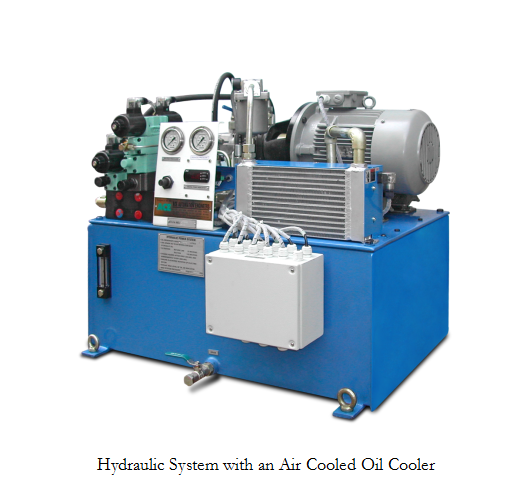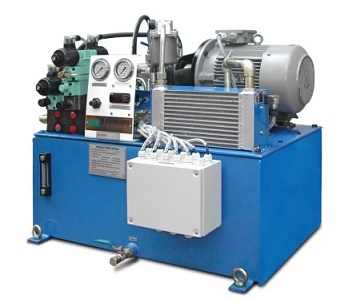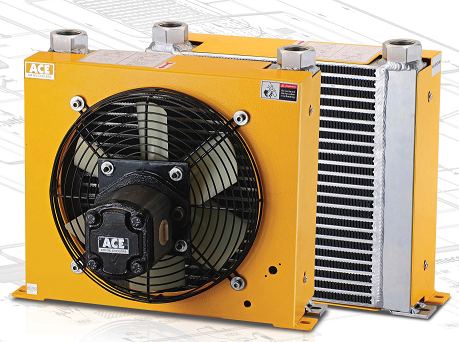Air cooled Oil Cooling of Hydraulic Systems of CNC Machines & other Equipment

Which oil cooler is better :- Air cooled Oil Cooler or Water cooled Oil Cooler ?
April 20, 2021
Air cooled oil cooling of Centralized Oil Lubrication Systems, Bearings & Bushes.
April 22, 2021Air cooled Oil Cooling of Hydraulic Systems of CNC Machines & other Equipment
Oil heating is caused by the inefficiencies of the equipment or system. These inefficiencies result in conversion of a part of the input power into heat. It is important that the heat generated is effectively dissipated, either naturally or using an oil cooler. In any reliable system we have to ensure that the heat dissipation capacity is higher than or equal to the heat generated. The commonly used or required parameters are as follows:
- Motor (KW)
- Pump (LPM)
- Working Pressure (BAR)
- Tank Capacity (LITRES)
- Ambient temperature at site (°C)
- Required Oil Temperature (°C)
- Pump used is Variable or Fixed displacement type
- Duty cycle.
- Application/ Industry.
In practice all of these may or may not be available. The user is advised to collect as much of the above information as possible.

Do all hydraulic systems need oil cooling?
For deciding whether a hydraulic system needs oil cooling or not, we need to consider if it’s a continuous duty system or an intermittent duty system. In intermittent duty systems the heat produced during the work cycle gets radiated naturally from the surface of oil tanks during the gaps between the work cycles. If the heat produced during the work cycle is less than or equal to the heat dissipated from the tank surface during periods of inactivity i.e. the gaps between work cycles, a heat exchanger is not required. In continuous duty systems which are working round the clock or for long durations of time, if the wasteful energy that is converted to heat can be dissipated effectively by radiation naturally from the surface of the tank we do not need an external oil cooler. The amount of heat that a tank can dissipate with respect to the temperature difference between the oil temperature & the temperature of the ambient air can be estimated with the help of the table. If the heat generation is more than what can be dissipated from the tank surface, an oil cooler should be installed. Most continuous duty systems with relatively large motors (greater than 2.2kW Or 3HP) do need an oil cooler to dissipate the heat.

What happens if we don’t install an oil cooler?
We can see from the Fig., the heat dissipation from the tank surface increases as the temperature difference between the oil & ambient air increases. If the heat generated in the hydraulic system is more than the heat dissipation capacity of the tank and there is no oil cooler installed. The temperature of the oil in the tank will keep rising till it equals the amount of heat that can be radiated from the tank surface. For instance, if we look at the hydraulic system with a 450 liter oil tank working in an environment with ambient temperature of 40°C. Let us say we want to restrict the oil temperature to 55°C.
- Oil tank capacity = 450 liters
- Ambient air temp. = 40 °C
- Max allowed oil temp. = 55 °C
- ΔT = 55- 40 = 15 °C
- From 10-1 Heat dissipation capacity = 1.06 KW
- If efficiency of hydraulic system η = 70%*
(i.e.) Heat Generation = 30% * Motor Power (KW)
*The rule of thumb: Efficiency of hydraulic systems with fixed displacement pumps is considered 70% & for systems with variable displacement pumps is considered 80%.
In this example let us consider that the installed motor power is 10 KW. Our equation now becomes:
- If efficiency η = 70%,
Heat generation = 30%*10KW = 3 KW (That’s equivalent to having a 3KW electrical heater inside the tank)
- Heat dissipation capacity = 1.06 KW
- Access heat production= 3 – 1.06 = 1.94 KW.
As the equipment operates, the temperature will keep rising till the heat dissipation from the tank surface equals 3KW. As we can see from the table, this will happen when the oil temp. reaches approximately 42.4 °C above the ambient temperature (i.e.) oil temperature of 82.4 °C. At that point there will be a state of equilibrium and oil temperature will stabilize. However at a temperature of 82.4 °C the viscosity of the oil would have reduced drastically, making it susceptible to internal & external leakages. Furthermore the additives added to the oil will irreversibly lose their properties. Therefore we have two options. Either to increase the size of the tank or install an oil cooler. Even if we did manage to increase the oil tank size, the economics will rarely justify this. Not only on account of expense of building the tank, as also the increased oil fill cost, each time we replace the oil. We also have to consider the cost of space occupied by such a large tank. Increasing the oil tank capacity therefore become unviable. We would need to install an oil cooler with a heat dissipation capacity of 1.94 or say 2 KW.
High hydraulic oil temperatures will progressively start damaging seals, internal moving parts and directly affect the power consumed, life & reliability of the equipment. For most continuous duty equipment we do need to have an external mechanism installed for dissipating that heat.



